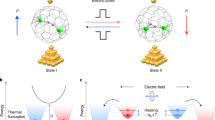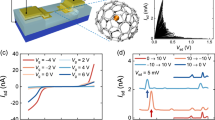Abstract
Electrets are dielectric materials that have a quasi-permanent dipole polarization. A single-molecule electret is a long-sought-after nanoscale component because it can lead to miniaturized non-volatile memory storage devices. The signature of a single-molecule electret is the switching between two electric dipole states by an external electric field. The existence of these electrets has remained controversial because of the poor electric dipole stability in single molecules. Here we report the observation of a gate-controlled switching between two electronic states in Gd@C82. The encapsulated Gd atom forms a charged centre that sets up two single-electron transport channels. A gate voltage of ±11 V (corresponding to a coercive field of ~50 mV Å–1) switches the system between the two transport channels with a ferroelectricity-like hysteresis loop. Using density functional theory, we assign the two states to two different permanent electrical dipole orientations generated from the Gd atom being trapped at two different sites inside the C82 cage. The two dipole states are separated by a transition energy barrier of 11 meV. The conductance switching is then attributed to the electric-field-driven reorientation of the individual dipole, as the coercive field provides the necessary energy to overcome the transition barrier.
This is a preview of subscription content, access via your institution
Access options
Access Nature and 54 other Nature Portfolio journals
Get Nature+, our best-value online-access subscription
$29.99 / 30 days
cancel any time
Subscribe to this journal
Receive 12 print issues and online access
$259.00 per year
only $21.58 per issue
Buy this article
- Purchase on Springer Link
- Instant access to full article PDF
Prices may be subject to local taxes which are calculated during checkout




Similar content being viewed by others
Data availability
The data shown in the paper are available at https://doi.org/10.6084/m9.figshare.12720392. Source data are provided with this paper.
Code availability
The density functional theory program used to analyse the results is available from the corresponding author on reasonable request.
References
Waldrop, M. M. The chips are down for Moore’s law. Nature 530, 144–147 (2016).
Huang, Y. L. et al. Reversible single-molecule switching in an ordered monolayer molecular dipole array. Small 8, 1423–1428 (2012).
Zhang, J. L. et al. Towards single molecule switches. Chem. Soc. Rev. 44, 2998–3022 (2015).
Jia, C. et al. Covalently bonded single-molecule junctions with stable and reversible photoswitched conductivity. Science 352, 1443–1445 (2016).
Blum, A. S. et al. Molecularly inherent voltage-controlled conductance switching. Nat. Mater. 4, 167–172 (2005).
Wagner, S. et al. Switching of a coupled spin pair in a single-molecule junction. Nat. Nanotechnol. 8, 575–579 (2013).
Diez-Perez, I. et al. Rectification and stability of a single molecular diode with controlled orientation. Nat. Chem. 1, 635–641 (2009).
Capozzi, B. et al. Single-molecule diodes with high rectification ratios through environmental control. Nat. Nanotechnol. 10, 522–527 (2015).
Batra, A. et al. Tuning rectification in single-molecular diodes. Nano Lett. 13, 6233–6237 (2013).
Sherif, S. et al. Current rectification in a single molecule diode: the role of electrode coupling. Nanotechnology 26, 291001 (2015).
Park, H. et al. Nanomechanical oscillations in a single-C60 transistor. Nature 407, 57–60 (2000).
Lau, C. S. et al. Redox-dependent Franck-Condon blockade and avalanche transport in a graphene-fullerene single-molecule transistor. Nano Lett. 16, 170–176 (2016).
Vincent, R., Klyatskaya, S., Ruben, M., Wernsdorfer, W. & Balestro, F. Electronic read-out of a single nuclear spin using a molecular spin transistor. Nature 488, 357–360 (2012).
Kubatkin, S. et al. Single-electron transistor of a single organic molecule with access to several redox states. Nature 425, 698–701 (2003).
Bai, Z. B. et al. A silicon cluster based single electron transistor with potential room-temperature switching. Chin. Phys. Lett. 35, 037301 (2018).
Gao, L. et al. Graphene-DNAzyme junctions: a platform for direct metal ion detection with ultrahigh sensitivity. Chem. Sci. 6, 2469–2473 (2015).
Xiao, X., Xu, B. & Tao, N. Changes in the conductance of single peptide molecules upon metal-ion binding. Angew. Chem. Int. Ed. 43, 6148–6152 (2004).
Evangeli, C. et al. Engineering the thermopower of C60 molecular junctions. Nano Lett. 13, 2141–2145 (2013).
Kato, C. et al. Giant hysteretic single-molecule electric polarization switching above room temperature. Angew. Chem. Int. Ed. 57, 13429–13432 (2018).
Pasupathy, A. N. et al. Vibration-assisted electron tunneling in C140 transistors. Nano Lett. 5, 203–207 (2005).
Yu, L. H. & Natelson, D. The Kondo effect in C60 single-molecule transistors. Nano Lett. 4, 79–83 (2004).
Roch, N., Florens, S., Bouchiat, V., Wernsdorfer, W. & Balestro, F. Quantum phase transition in a single-molecule quantum dot. Nature 453, 633–637 (2008).
Winkelmann, C. B., Roch, N., Wernsdorfer, W., Bouchiat, V. & Balestro, F. Superconductivity in a single-C60 transistor. Nat. Phys. 5, 876–879 (2009).
Danilov, A. V., Kubatkin, S. E., Kafanov, S. G. & Bjornholm, T. Strong electronic coupling between single C60 molecules and gold electrodes prepared by quench condensation at 4 K. A single molecule three terminal device study. Faraday Discuss. 131, 337–345 (2006).
Rosseinsky, M. J. et al. Superconductivity at 28 K in RbXC60. Phys. Rev. Lett. 66, 2830–2832 (1991).
Morton, J. J. L. et al. Environmental effects on electron spin relaxation in N@C60. Phys. Rev. B 76, 085418 (2007).
Funasaka, H., Sugiyama, K., Yamamoto, K. & Takahashi, T. Magnetic properties of rare-earth metallofullerenes. J. Phys. Chem. 99, 1826–1830 (1995).
Huang, H., Yang, S. & Zhang, X. Magnetic properties of heavy rare-earth metallofullerenes M@C82 (M = Gd, Tb, Dy, Ho, and Er). J. Phys. Chem. B 104, 1473–1482 (2000).
de Nadai, C. et al. Local magnetism in rare-earth metals encapsulated in fullerenes. Phys. Rev. B 69, 184421 (2004).
Kitaura, R., Okimoto, H., Shinohara, H., Nakamura, T. & Osawa, H. Magnetism of the endohedral metallofullerenes M@C82 (M = Gd, Dy) and the corresponding nanoscale peapods: synchrotron soft X-ray magnetic circular dichroism and density-functional theory calculations. Phys. Rev. B 76, 172409 (2007).
Okamura, N., Yoshida, K., Sakata, S. & Hirakawa, K. Electron transport in endohedral metallofullerene Ce@C82 single-molecule transistors. Appl. Phys. Lett. 106, 043108 (2015).
Laasonen, K., Andreoni, W. & Parrinello, M. Structural and electronic properties of La@C82. Science 258, 1916–1918 (1992).
Nuttall, C. J., Hayashi, Y., Yamazaki, K., Mitani, T. & Iwasa, Y. Dipole dynamics in the endohedral metallofullerene La@C82. Adv. Mater. 14, 293–296 (2002).
Thijssen, J. M. & van der Zant, H. S. J. Charge transport and single-electron effects in nanoscale systems. Phys. Status Solidi B 245, 1455–1470 (2008).
Quan, X. & Hutchison, G. R. Single molecule ferroelectrics via conformational inversion: an electronic structure investigation. Preprint at https://arxiv.org/abs/1705.09699 (2017).
Blöchl, P. E. Projector augmented-wave method. Phys. Rev. B 50, 17953–17979 (1994).
Kresse, G. & Joubert, D. From ultrasoft pseudopotentials to the projector augmented-wave method. Phys. Rev. B 59, 1758–1775 (1999).
Kresse, G. & Furthmüller, J. Efficient iterative schemes for ab initio total-energy calculations using a plane-wave basis set. Phys. Rev. B 54, 11169–11186 (1996).
Lee, K., Murray, É. D., Kong, L., Lundqvist, B. I. & Langreth, D. C. Higher-accuracy van der Waals density functional. Phys. Rev. B 82, 081101 (2010).
Dion, M., Rydberg, H., Schroder, E., Langreth, D. C. & Lundqvist, B. I. Van der Waals density functional for general geometries. Phys. Rev. Lett. 92, 246401 (2004).
Klimeš, J., Bowler, D. R. & Michaelides, A. Van der Waals density functionals applied to solids. Phys. Rev. B 83, 195131 (2011).
Hong, J. et al. Exploring atomic defects in molybdenum disulphide monolayers. Nat. Commun. 6, 6293 (2015).
Qiao, J., Kong, X., Hu, Z. X., Yang, F. & Ji, W. High-mobility transport anisotropy and linear dichroism in few-layer black phosphorus. Nat. Commun. 5, 4475 (2014).
Qiao, J. et al. Few-layer tellurium: one-dimensional-like layered elementary semiconductor with striking physical properties. Sci. Bull. 63, 159–168 (2018).
Zhao, Y. et al. Extraordinarily strong interlayer interaction in 2D layered PtS2. Adv. Mater. 28, 2399–2407 (2016).
Zhao, Y. et al. High‐electron‐mobility and air‐stable 2D layered PtSe2 FETs. Adv. Mater. 29, 1604230 (2017).
Sheppard, D., Terrell, R. & Henkelman, G. Optimization methods for finding minimum energy paths. J. Chem. Phys. 128, 134106 (2008).
Sheppard, D., Xiao, P., Chemelewski, W., Johnson, D. D. & Henkelman, G. A generalized solid-state nudged elastic band method. J. Chem. Phys. 136, 074103 (2012).
Neugebauer, J. & Scheffler, M. Adsorbate-substrate and adsorbate-adsorbate interactions of Na and K adlayers on Al(111). Phys. Rev. B 46, 16067–16080 (1992).
Ding, W. et al. Prediction of intrinsic two-dimensional ferroelectrics in In2Se3 and other III2-VI3 van der Waals materials. Nat. Commun. 8, 14956 (2017).
Perdew, J. P., Burke, K. & Ernzerhof, M. Generalized gradient approximation made simple. Phys. Rev. Lett. 77, 3865–3868 (1996).
Petersen, M., Hafner, J. & Marsman, M. Structural, electronic and magnetic properties of Gd investigated by DFT+U methods: bulk, clean and H-covered (0001) surfaces. J. Phys. Condens. Matter 18, 7021–7043 (2006).
Tao, K. et al. Self-consistent determination of Hubbard U for explaining the anomalous magnetism of the Gd13 cluster. Phys. Rev. B 89, 085103 (2014).
Harmon, B. N., Antropov, V. P., Liechtenstein, A. I., Solovyev, I. V. & Anisimov, V. I. Calculation of magneto-optical properties for 4f systems: LSDA + Hubbard U results. J. Phys. Chem. Solids 56, 1521–1524 (1995).
Acknowledgements
We gratefully acknowledge the financial support of the National Key R&D Program of China (2017YFA0303203, 2018YFE0202700, 2018YFA0306004 and 2016YFA0300101), the National Natural Science Foundation of China (U1732273, 21973038, 91961101, 61761166009, 11522432, 11574217, U1732159, 61822403, 11874203, 11904166, 11622437, 61674171, 11974422, 21721001, 91961112, 11227904, 61521001 and 61801209), the Strategic Priority Research Program of Chinese Academy of Sciences (grant no. XDB30000000), the Fundamental Research Funds for the Central Universities, China, and the Research Funds of Renmin University of China (grants no. 16XNLQ01 and 19XNQ025), the Fundamental Research Funds for the Central Universities (020414380082, 020414380127, 020414380150 and 020414380151) and the opening Project of the Wuhan National High Magnetic Field Center. C.W. was supported by the Outstanding Innovative Talents Cultivation Funded Programs 2017 of Renmin University of China. Calculations were performed at the Physics Lab of High-Performance Computing of Renmin University of China and Shanghai Supercomputer Center. S.-F.S. acknowledges support from NSF Career Grant DMR-1945420 and NYSTAR through Focus Center-NY–RPI contract C150117. We thank H.-L. Cai from Nanjing University for stimulating discussions. We also thank S.-T. Zhang from Nanjing University for preparing bulk materials.
Author information
Authors and Affiliations
Contributions
F.S. conceived the research and B.W., W.J., S.-Y.X., S.-F.S. and M.A.R. co-supervised the project. M.Z. performed the bulk material measurements. C.W. and W.J. performed and analysed the density functional theory calculations. Z.B. designed and fabricated the devices. K.Z. performed the SMD measurements. F.-F.X. performed high-performance liquid chromatography for purification of the molecular materials. Y.-Z.T. participated in the separation of the molecular materials. S.-Y.X. prepared the molecular materials. X.T. and D.P. assisted in the device fabrication. Y.G. and J.W. assisted with the density functional theory calculations. K.Z., C.W., F.S., W.J. and M.A.R. wrote the paper. K.-J.H., L.C., S.Z., L.K., J.C., P.W., X.W., J.L., Y.S. and G.W. participated in discussions on this manuscript. All authors discussed the results and commented on the manuscript.
Corresponding authors
Ethics declarations
Competing interests
The authors declare no competing interests.
Additional information
Peer review information Nature Nanotechnology thanks Sadafumi Nishihara and the other, anonymous, reviewer(s) for their contribution to the peer review of this work.
Publisher’s note Springer Nature remains neutral with regard to jurisdictional claims in published maps and institutional affiliations.
Supplementary information
Supplementary Information
Supplementary Figs. 1–11, Tables 1–4 and refs. 1–3.
Source data
Source Data Fig. 1
Statistical Source Data
Source Data Fig. 2
Statistical Source Data
Source Data Fig. 3
Statistical Source Data
Source Data Fig. 4
Statistical Source Data
Rights and permissions
About this article
Cite this article
Zhang, K., Wang, C., Zhang, M. et al. A Gd@C82 single-molecule electret. Nat. Nanotechnol. 15, 1019–1024 (2020). https://doi.org/10.1038/s41565-020-00778-z
Received:
Accepted:
Published:
Issue Date:
DOI: https://doi.org/10.1038/s41565-020-00778-z
This article is cited by
-
Electrically controlled nonvolatile switching of single-atom magnetism in a Dy@C84 single-molecule transistor
Nature Communications (2024)
-
0D van der Waals interfacial ferroelectricity
Nature Communications (2023)
-
Self-assembled photonic cavities with atomic-scale confinement
Nature (2023)
-
An artificial synapse based on molecular junctions
Nature Communications (2023)
-
Room-temperature logic-in-memory operations in single-metallofullerene devices
Nature Materials (2022)



